Coffee brewing has evolved into a fascinating journey in Southeast Asia, with more and more people exploring the myriad ways to craft the perfect cup of coffee at home. The sheer variety of coffee brewing methods available ensures that there’s a unique experience waiting for everyone.
Some people like a French press’s robust and rich flavor, while others prefer a pour-over’s clean and light taste. There are even methods like AeroPress, a unique method that uses air pressure to extract flavor, for a quick cup on the go.
In this guide, we’ll look at the different ways to make coffee and help you determine which one might be best for you. Whether you like a robust, full-bodied, or a smooth, balanced cup, we’ve got you covered. Let’s dive in and find the best way to brew coffee at home.
The Classics (Focus on Ease and Accessibility)
When it comes to how to make coffee with ease and accessibility, the classics are a great place to start. These methods are simple, straightforward, and perfect for those who want to enjoy a great cup without fuss.
From the iconic French Press to the trusty Moka pot, these approaches are designed to offer satisfying results with minimal effort.
Whether you’re seeking bold, rich flavors or a smooth, balanced brew, exploring these classic types of coffee will guide you to the best way to make coffee at home.
Let’s dive into some of the timeless methods that remain favorites among coffee lovers.
1. French Press

The French Press is one of the simplest methods for making coffee at home, and it’s a favorite among coffee enthusiasts for its rich, bold flavors.
This method uses total immersion, allowing coffee grounds to steep in hot water. This results in a profoundly flavorful brewed coffee. As the grounds stay in contact with the water for several minutes, they release more oils and compounds, giving French press coffee its distinctive full-bodied taste.
Let’s learn how to brew through a French press, step by step:
- Measure the Coffee: Use a 1:15 ratio; for a 34 oz French Press, that’s about 56 grams (8 tablespoons).
- Boil Water: Heat until boiling, then excellent for 30 seconds to around 200 degrees Fahrenheit or 93 degrees Celsius.
- Add Coffee and Water: Add grounds to the press, pour in hot water, and stir gently.
- Steep: Place the lid on the French Press and steep for 4 minutes. If you find that your coffee is too weak, try steeping for an additional minute. If it’s too strong, reduce the steeping time by a minute.
- Press and Pour: Slowly press down the plunger, pour into your cup, and enjoy.
Bean Recommendation and Flavor Profile
Medium to dark roast blends are ideal for a French Press, as French Press coffee is full-bodied and robust, with a rich, intense flavor.
This brewing method is ideal for those who like a stronger cup and are okay with a bit of sediment at the bottom, a common feature of French press coffee.
Grind Recommendation: Coarse grind—like sea salt.
2. Moka Pot (Stovetop Espresso)
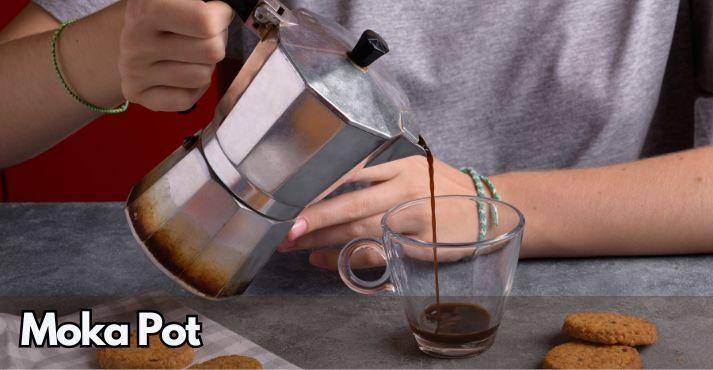
The Moka pot is a classic stovetop brewer that offers one of the most straightforward yet effective ways to make coffee at home. It operates by heating water in its lower chamber, creating pressure that forces the hot water through the ground coffee into the upper chamber.
This process results in a rich and aromatic coffee with an intensity similar to espresso without needing a complex machine. The Moka pot is perfect for those who enjoy a concentrated brew and want an authentic Italian-style coffee experience. To make it easier for our readers, here is a guide to enjoy this experience easily at home.
- Add Water: Fill the lower chamber to just below the safety valve.
- Add Coffee: Use a fine-to-medium grind, filling the filter basket without packing it too tightly.
- Assemble and Heat: Secure the upper chamber, then place the Moka pot on a stovetop with medium heat.
- Listen for the Gurgle: This indicates the brewing is nearly complete (about 3-5 minutes). Remove from heat to avoid over-extraction.
- Serve and Enjoy: Pour the coffee into a cup or use it as a base for other drinks like lattes or cappuccinos.
Beans and Flavor Profile
Choose a medium to dark roast for a rich and bold coffee. Coffee brewed with the Moka pot is strong, aromatic, and similar in intensity to espresso.
It’s a must-have for those who appreciate the ritual of coffee making and enjoy robust and concentrated coffee without needing additional F&B service equipment.
Grind Recommendation: Fine-to-medium grind for best results.
The Pour-Over Methods (Focus on Control and Technique)
Pour-over brewing methods provide a precise and hands-on approach to coffee making. These methods allow coffee enthusiasts to control the water flow, temperature, and brewing time, allowing for a customized cup with subtle nuances.
When considering how to make ground coffee, it’s essential to consider the techniques behind your beans and the impact of different brewing techniques on flavor. Let’s explore two popular pour-over methods, the V60, and the Chemex, that exemplify these concepts.
3. V60 Pour-Over
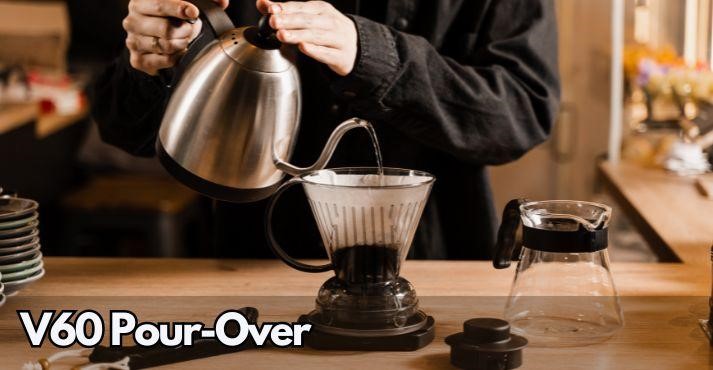
The V60 pour-over is popular for those who appreciate a clean and precise coffee-making process. It uses a cone-shaped dripper and a paper filter, allowing hot water to flow through the coffee grounds in a controlled, circular motion.
This technique highlights subtle flavors, making it a favorite for exploring the unique characteristics of different coffee beans. We will now look at the making process:
- Set-Up: Place a V60 cone on a carafe or mug with a paper filter. Rinse with hot water to remove any paper taste.
- Add Coffee: Use a medium-fine grind (like granulated sugar). For a 12-ounce cup, 24 grams of coffee works well.
- Bloom: Pour a small amount of hot water, around 200 degrees Fahrenheit or 93 degrees Celsius, over the grounds and let them bloom for 30 seconds.
- Complete the Pour: Pour the rest of the water slowly, circularly. This should take about 2-3 minutes.
- Serve: After brewing, enjoy your coffee.
Beans and Flavor Profile:
The V60 works with various coffee types, including robusta coffee beans, for a bold flavor. Try to go for sustainable and ethical coffee options. The V60 brew is clean and allows the subtle flavors of the coffee to stand out.
Grind Recommendation: Medium-fine, resembling the texture of granulated sugar or table salt.
4. Chemex

The Chemex is a classic among coffee brewing methods, known for its sleek design and exceptional coffee quality. The brewing process involves pouring hot water over the coffee grounds in a controlled manner, allowing it to seep through a thick paper filter.
This filter is vital to Chemex’s unique quality. It removes excess oils and sediment, resulting in a clean and crisp cup of coffee.
- Set-Up: Place a Chemex filter in the Chemex carafe and rinse with hot water to eliminate any paper taste.
- Add Coffee: Use a medium-coarse grind, like kosher salt. For a 6-cup Chemex, a typical ratio is 45 grams of coffee to 720 ml of hot water.
- Bloom: Pour a small amount of hot water, around 200 degrees Fahrenheit or 93 degrees Celsius, over the coffee grounds and let it bloom for 30 seconds.
- Complete the Pour: Continue pouring the rest of the hot water slowly, circularly, aiming for a total brew time of 3-5 minutes.
- Serve: After brewing, discard the filter and pour your coffee into cups.
Beans and Flavor Profile:
The Chemex is versatile, allowing for various coffee types. Medium roast beans work well for a balanced flavor profile. It delivers smooth coffee with clarity.
This method is ideal for those who enjoy the aesthetics of coffee brewing and value a smooth flavor profile. It’s also an excellent choice for brewing multiple cups simultaneously, making it perfect for sharing.
Grind Recommendation: Medium-coarse, similar to kosher salt.
Immersion Methods (Focus on Full-Body Coffee)
Immersion methods are designed for coffee enthusiasts who prefer a deeper, more robust flavor. These techniques involve submerging coffee grounds in water, allowing for longer extraction times and richer results.
If you’re wondering how to brew coffee to achieve a full-bodied cup, immersion methods like AeroPress are the answer. By letting the coffee grounds steep, these methods bring out the intensity and depth that many coffee lovers crave.
If you’ve been curious about how to make ground coffee yield its fullest potential, these immersion techniques are worth exploring.
5. Cold Brew
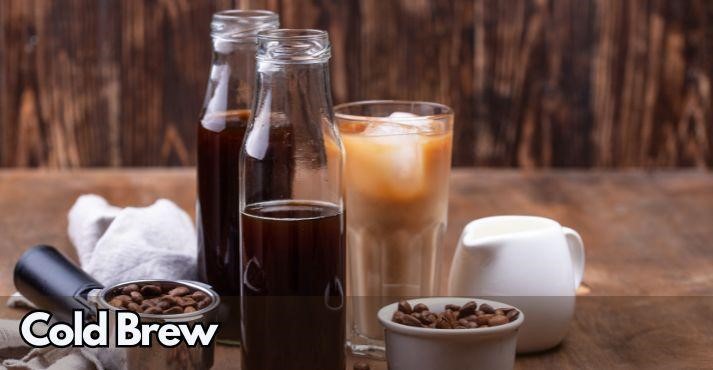
Cold brew coffee is known for its low acidity and smooth flavor profile, making it an excellent choice for those who prefer a milder coffee experience. The brewing process involves steeping coarsely ground coffee in cold water for an extended period, typically 12 to 24 hours.
This slow extraction results in a rich and mellow coffee concentrate that can be diluted with water, milk, or cream to achieve the desired strength. Cold brew is ideal for making large batches, providing a convenient and refreshing coffee option for hot days or busy schedules.
Let’s take a look at the steps to make a cold brew:
- Measure Coffee and Water: Use a ratio of 1:4 coffee to water. For a 32 oz cold brew, that’s about 80 grams of coffee.
- Steep: Add coarsely ground coffee to a large jar or cold brew maker, then pour in cold water. Stir to ensure all the grounds are saturated. Cover and refrigerate for 12 to 24 hours.
- Filter: After steeping, strain the coffee to remove the grounds. You can use a fine mesh strainer, a cheesecloth, or a dedicated cold brew filter.
- Dilute and Serve: Dilute the coffee concentrate with water, milk, or cream to taste. Serve over ice for a refreshing, cold coffee.
Beans and Flavor Profile:
Cold brew works well with medium to dark roast beans for a rich and smooth flavor. The slow extraction results in smooth and soft taste. It’s easy to customize by adjusting the dilution and adding flavorings like vanilla or caramel.
Grind Recommendation: Coarse, similar to breadcrumbs.
6. AeroPress
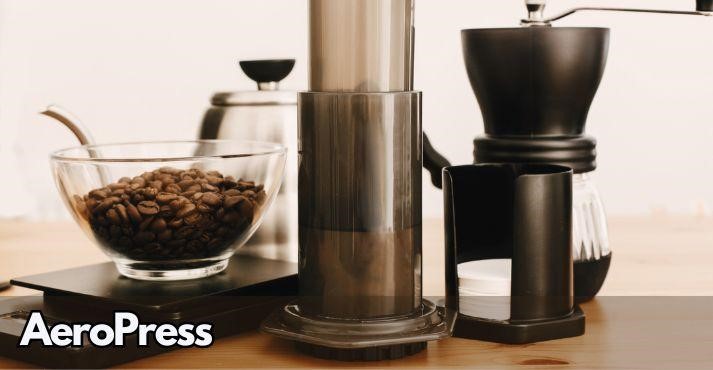
AeroPress is a versatile coffee brewing method appreciated for its convenience and portability. It’s an excellent choice for coffee enthusiasts who are always on the go, as it’s lightweight and easy to pack for travel or outdoor adventures.
The brewing process is straightforward. The steps are:
- Assemble the AeroPress: Insert a paper filter into the cap and rinse it with hot water to remove any paper taste.
- Add Coffee Grounds: Use a medium-fine grind. About 14-18 grams (1-2 tablespoons) is ideal for a standard AeroPress.
- Add Hot Water: Pour hot water around 200 degrees Fahrenheit or 93 degrees Celsius to the top of the AeroPress chamber. Stir gently to ensure even saturation of the coffee grounds.
- Press: Attach the plunger and press down slowly, aiming for a 20-30 second press time.
- Serve: Remove the AeroPress from your cup and enjoy the coffee once fully pressed.
Beans and Flavor Profile:
The AeroPress works with a variety of beans. Consider using medium to dark roast for a richer flavor. It creates a clean, crisp coffee with a concentration similar to espresso. It is less intense than traditional espresso but offers a smooth and balanced cup.
This method is perfect for those who enjoy experimenting with coffee brewing techniques and appreciate a quick, clean brew.
Grind Recommendation: Medium-fine, similar to table salt.
Alternative Brewing Methods (Focus on Unique Experiences)
Alternative brewing methods offer unique experiences for those seeking new ways to brew coffee at home. These techniques combine creativity with a touch of tradition, providing a distinct approach to extracting flavors from single-origin coffee.
Whether you’re looking for a visually captivating brewing process or a taste that deviates from the norm, these methods can be the best way to make coffee for those who crave variety and innovation. Let’s explore some of these unconventional yet intriguing coffee brewing methods.
7. Siphon (Vacuum Pot Coffee)
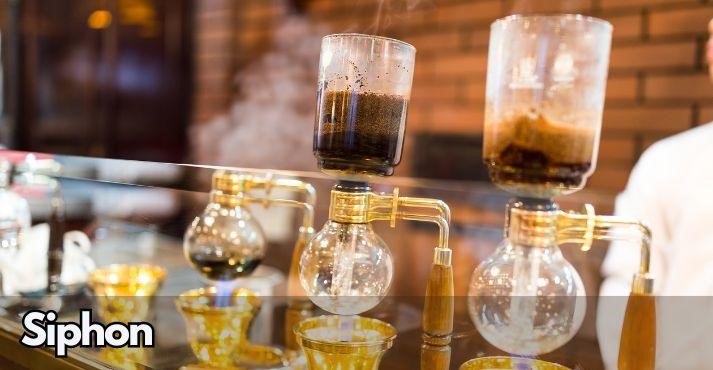
The siphon coffee maker offers more than just a delicious cup of coffee; it provides a theatrical performance that engages coffee lovers on a multisensory level.
The brewing process involves heating water in the lower chamber until it creates vapor pressure, which forces the water into the upper chamber, which mixes with the coffee grounds.
Let’s take a look at a step-by-step guide to make it:
- Assemble the Siphon: Set up the siphon coffee maker, ensuring a tight seal. Fill the lower chamber with water.
- Add Coffee Grounds: Use a medium-coarse grind. A standard ratio is 1:15, or about 20-25 grams of coffee for a standard siphon.
- Heat the Water: Apply heat to the lower chamber. The hot water rises to the upper chamber as it vaporizes, mixing with the coffee grounds.
- Stir and Steep: Stir gently once the water reaches the upper chamber. Allow the coffee to steep for 1-2 minutes.
- Vacuum Extraction: Remove the heat source to create the vacuum that pulls the brewed coffee into the lower chamber.
- Serve: Once the coffee is fully extracted, pour it into a cup and enjoy.
Beans and Flavor Profile:
The siphon coffee maker brings out subtle flavors, so choose a single-origin medium roast for a balanced profile or a dark roast for deeper, more intense flavors.
Siphon coffee is known for its clean taste and balanced body, often developing the aroma and exposing the unique notes of the coffee beans. The result is a nuanced cup with a rich aroma.
The siphon coffee maker is a conversation starter and a favorite among coffee fans who appreciate the art and science behind coffee brewing.
Grind Recommendation: Medium-coarse grind for optimal results.
8. Vietnamese Phin Filter
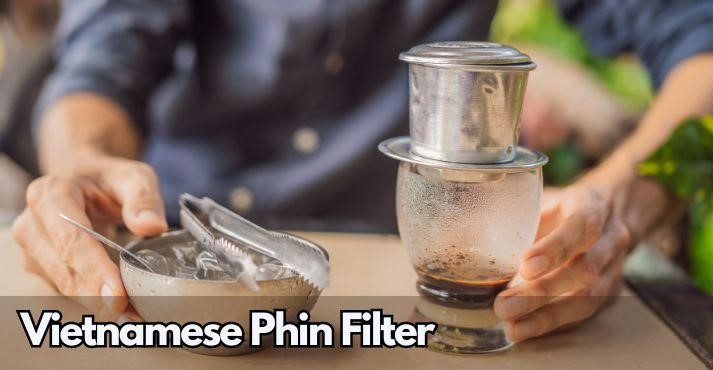
The Vietnamese phin filter is a classic way to make coffee. It offers a robust and aromatic brew often enjoyed with condensed milk for a traditional Vietnamese coffee experience.
To use the phin filter, place the coffee grounds in the filter, pour hot water over them, and let the coffee drip slowly into the cup below.
Let’s look at how it is done :
- Set-Up: Place the phin filter on top of your coffee cup. Add a paper filter if desired.
- Add Coffee Grounds: Use a medium-coarse grind. 20-25 grams of coffee works well for a standard phin filter.
- Add Hot Water: Pour a small amount of hot water around 200 degrees Fahrenheit or 93 degrees Celsius to let the coffee develop for about 30 seconds.
- Complete the Pour: Gradually add the remaining hot water, allowing it to drip through the grounds slowly. This can take 4-6 minutes.
- Serve: Once all the water has passed through, remove the phin filter, add condensed milk if desired, and enjoy.
Beans and Flavor Profile:
Choose a medium-coarse grind for the best extraction. Robusta beans are commonly used for their strong and bold flavor.
This method is known for its slower brewing time, which allows for a rich and full-bodied coffee. Adding condensed milk brings sweetness and creaminess, balancing the bold coffee flavor.
This method is one of the most popular ways to make coffee in Southeast Asia, ideal for those who enjoy a more indulgent coffee experience.
Grind Recommendation: Use a medium-coarse grind for the best extraction.
Coffee Brewing Methods (FAQs)
What is the most robust coffee brewing method?
Espresso is widely considered the most robust coffee brewing method due to its high concentration of coffee solids and intense flavor. Using pressure to extract coffee results in a potent shot with a robust and bold taste.
What is the least bitter coffee brewing method?
Cold brew is often the least bitter coffee brewing method. The extended steeping process in cold water extracts coffee with minimal acidity and bitterness, resulting in a smooth, mellow coffee that is easy on the palate.
Which coffee brewing method has the most flavor?
The pour-over methods, such as the V60 and Chemex, are known for extracting a wide range of flavors from coffee. These methods allow for precise control over brewing variables, resulting in a coffee that highlights the unique characteristics of the beans.
Can you make espresso in a French Press?
While the French Press cannot create authentic espresso due to its lack of pressure, it can produce a concentrated and robust coffee with a similar flavor profile. You can achieve a bold and intense coffee similar to espresso by using a finer grind and reducing the steeping time.
Conclusion
In Southeast Asia, coffee brewing has transformed into a captivating process, with various methods offering distinct experiences. Whether you prefer the classic French Press or the visually stunning siphon coffee maker, there are coffee brewing methods to suit every taste.
The diversity of brewing techniques allows coffee lovers to explore and discover new flavors, aromas, and textures, enriching their coffee journey.
From classic brewing methods to alternative and innovative techniques, the world of coffee brewing continues to evolve, offering endless possibilities for coffee enthusiasts to enjoy their favorite beverage.
So explore the different coffee brewing methods, experiment with grind sizes and brewing techniques, and start your coffee journey today.








